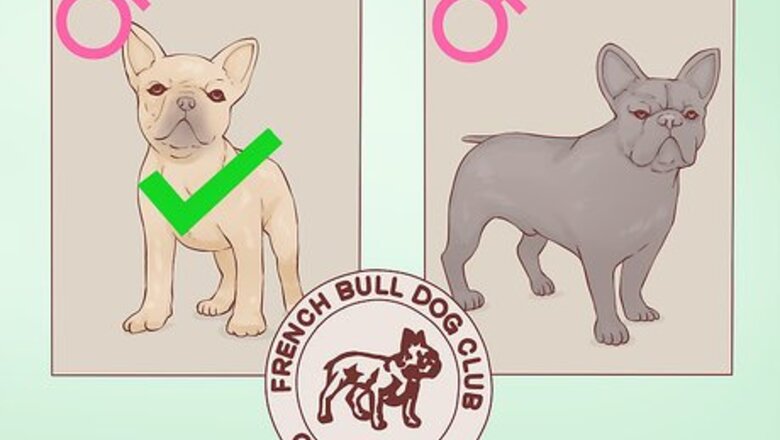
views
X
Trustworthy Source
American Kennel Club
The American Kennel Club (AKC) is a purebred dog pedigree registry in the United States. The AKC advocates for the responsible ownership of dogs and promotes purebred dog events, such as the Westminster Dog Show.
Go to source
Finding Foundation Stock to Breed
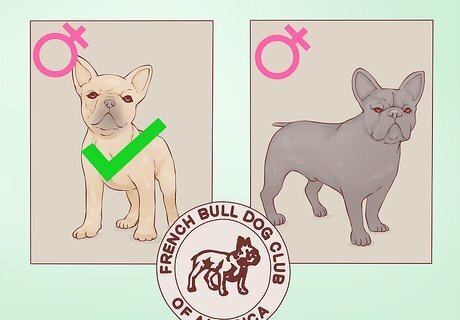
Select the right female. If you are looking to breed, you should start by obtaining a healthy bitch (female) puppy from a reputable breeder. The French Bulldog Club of America (FBDCA) has a registry of vetted breeder who are pledged to adhere to the breed standard and a rigorous code of ethics. You want to choose a female who has parents that are registered with the American Kennel Club, have health certifications that show they’re free from genetic defects, and come with established pedigrees so that you’re sure of their quality lineage. When you're choosing a breeder, talk to multiple people to make sure they provide quality care to their animals. The breeder should also allow you to see both parents of the puppy you're considering.
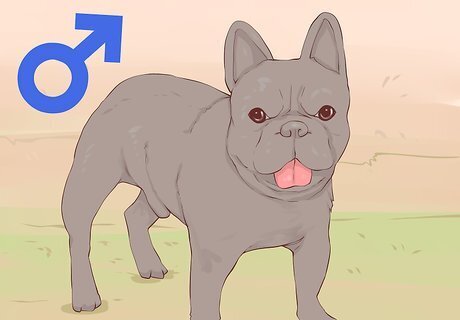
Find the right stud. Generally, you will seek out the services of a male dog rather than owning one yourself. You can search for a good sire at dog shows, with reputable breeders, and in breed publications where studs are advertised. Choose a male with characteristics that you’d like to combine with your female. For instance, he might have a desirable color that complements your female or traits that would address one of her deficiencies, such as a small skull. Always ask for photos, an official pedigree, and health certifications when considering a stud. It’s also important to inquire about the litters that they’ve sired so that you can assess if they breed well. Never breed dogs that are closely related to avoid genetic defects; however, dogs that are distantly related (for instance, they have a shared great uncle) often produce well together.
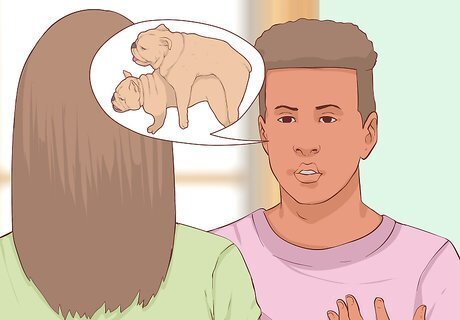
Set the terms for breeding. You can always negotiate, but the stud’s owner will generally lay out the initial terms for when, where, and how their dog will mate with yours. Figure out if you will use natural or artificial insemination, where the mating will take place, and how much the stud’s owner will charge for his services.
Breeding Your Puppies
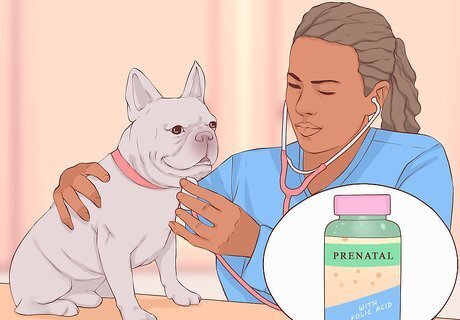
Make sure the mother is healthy. Take her for a veterinary check-up before she comes into season to improve her chances of a healthy pregnancy. She should have had her canine distemper and parvovirus vaccinations within the last 12 months and be covered for the time of her pregnancy. Check to be sure that she is free of intestinal worms, heartworms, and other diseases or parasites that could affect her puppies. It’s also a good idea to start giving your bitch prenatal supplements, including folic acid, iodine, and vitamin E.

Track your female’s fertility cycle. You will need to know when your bitch is in season in order to effectively breed her. You can tell that she’s in heat when she starts spotting and displaying irritable behavior. About five days into her season, start bringing her to the vet to test to see if she’s ovulating. There’s usually a two to three day window when she’ll be at peak fertility. Vets can use vaginal smears and progesterone testing to confirm when she’s ready to mate. Then, you just need to make sure that your stud is ready to perform his duty.
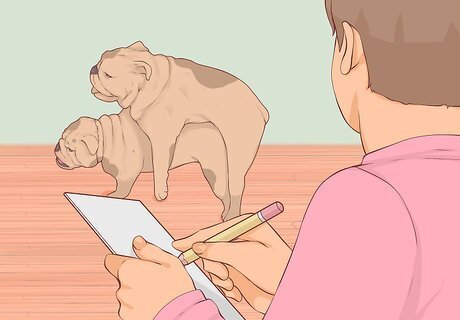
Mate your female and male. As soon as your vet confirms that your bitch is ovulating, it’s time to do the breeding. You can arrange to do this in person with monitored natural intercourse or through artificial insemination with the help of a vet. To enhance the chances of pregnancy, inseminate your bitch two times on two different days, doing so either on consecutive days or waiting a day in between. If you choose to do the former, arrange whether you’ll go to the stud or whether he’ll come to you. Make sure that their breeding is closely monitored to prevent any potential aggression. Many breeders do not favor natural breeding because of the risks of violence and infection. If you choose to go for artificial insemination, have the stud’s chilled semen sent to your vet. Be sure to keep track of the breeding days so that you can better estimate your female’s due date.
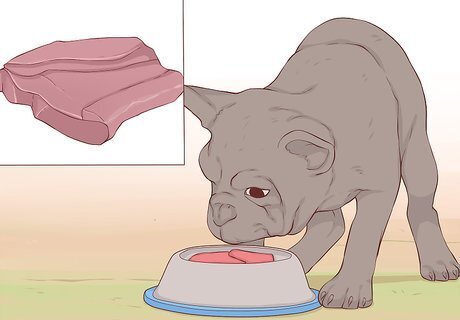
Pamper the mother. The pregnancy will generally take around 60 – 68 days. During that time, keep your expectant dog clean, well-hydrated, and well-nourished. Be sure that she’s eating a complete and balanced food that’s high in protein and fat, plus fortified with vitamins and minerals, especially folic acid and calcium for the sake of embryonic development. Keep the mother on her regular amount of food in the first half of the pregnancy as weight gain at this stage can increase the risk of whelping difficulties. Some breeders recommend feeding the mother half an ounce of raw liver (pork, beef, or venison) each day in addition to their kibble. Some breeders also suggest switching the mother over from adult to puppy food around the fifth week of their pregnancy and through nursing to ensure they’re getting the vitamins and minerals necessary for puppy development. Sometimes mothers get morning sickness and aren’t inclined to eat. If you find that’s the case, tempt her with something she likes to eat. Bland foods like chicken and rice are often safe bets.
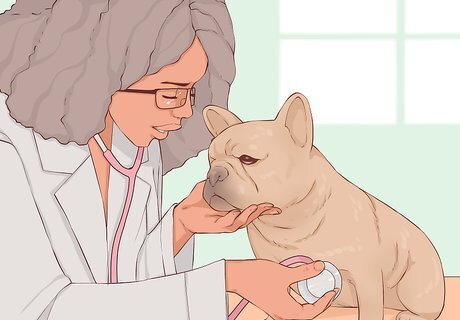
Confirm your dog’s pregnancy. It’s often hard to tell if your female has a litter on board or not. Inseminations are generally only 70% successful, and she won’t start showing until seven weeks, if at all. You can determine if she’s pregnant by going to the vet. The vet can use a Relaxin blood test from 25+ days, a sonogram from 28+ days, and an xray from 45+ days from the first day of breeding to confirm if your bitch is pregnant. Even if you think she’s not pregnant, always be sure to check. Sometimes small litters are difficult to detect.
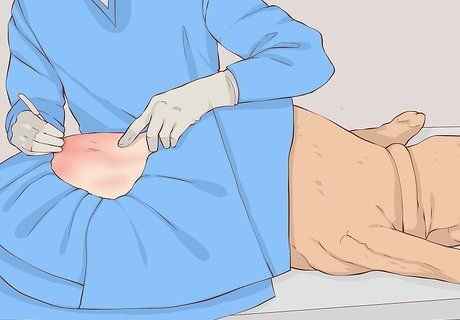
Arrange for a c-section. Natural birth is difficult for French Bulldogs because of the pups’ large heads and the mother’s small pelvis and labored breathing. More than 80% of French Bulldogs cannot or should not give birth naturally due to the risk of puppy fatalities and of maternal uterine damage, infections, and death. Keep track of when your bitch is due, and have an experienced vet on-call who is ready to deliver the litter by caesarean section. French Bulldogs puppies generally gestate for between 59 – 63 days from the time of breeding. You can generally gauge the onset of labor by the mother’s behavior (discomfort, agitation, lack of appetite, and/or nesting behavior) and by taking her rectal temperature. If you notice it drops by at least a degree, that’s a good sign that she has gone into labor. After the c-section, be sure to monitor the incision for discharge or infections. If you notice any discharge, clean it with hydrogen peroxide. If it continues or you notice significant redness and swelling, take her to the vet immediately. Note that other spotting and discharge is normal for a dog for a few days after birth.
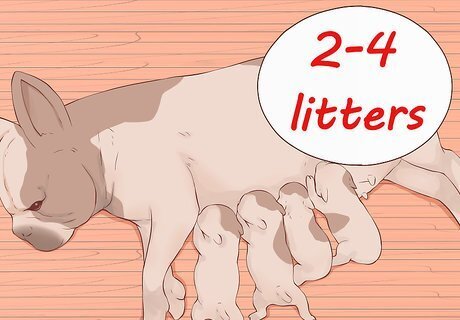
Limit the litters for each female. Due to the trauma of the birthing process for French Bulldogs, it’s important not to put bitches through too many pregnancies. Stick to 2-4 litters per mother, and stop breeding her immediately if pregnancy is compromising her health or if she’s producing stock with defects.
Caring for and Selling Your Puppies
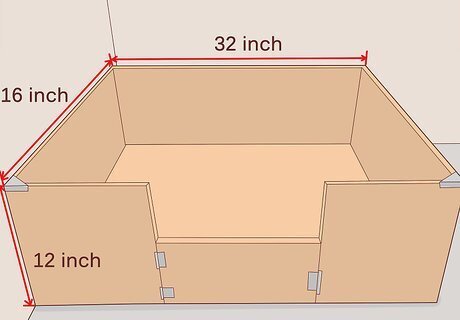
Set up a whelping box. It should be a rectangular box with walls high enough to keep the puppies in. The recommended dimensions are 32” x 16” and at least 12” in height. It should also have soft, clean bedding and a source of heat. Keep the box protected from any disturbances, especially quarantined away from other dogs or animals. The bedding should be soft and uneven, such as an egg-crate foam with towels on top. This will prevent your puppies from developing flat chests or splayed legs. Use an adjustable heat lamp to keep your puppies warm. The climate in the box should be kept around 95°F (53°C) during the first week, 85°F (29.4°C) the second, and at 75°F (23.9°C) from then on. Be sure to adjust the temperature according to the puppies’ behavior. If all of them are huddled under the lamp, turn it up. If all of them are huddled on the opposite side from the lamp, turn it down.
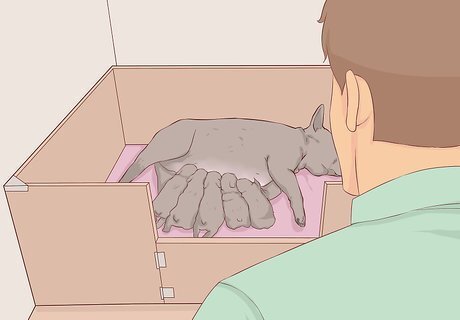
Monitor your pups’ arrival. Put the litter in the whelping box with their mother and keep constant watch over them for the first few hours to ensure that your bitch is prepared to assume her motherly duties. Sometimes moms can be aggressive, even towards their own offspring. As soon as you see her relax and start cleaning her pups and allowing them to feed, you can be sure that she has acknowledged them as her babies.
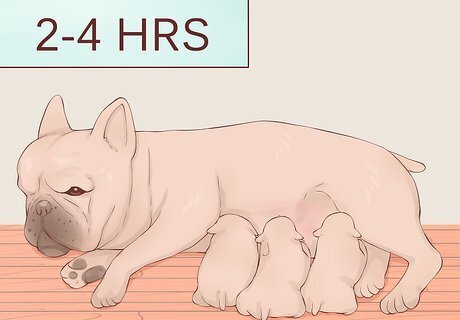
Make sure the litter is well-fed. Immediately after they’re born, puppies need to feed every two to four hours. Sometimes they can be slow on the uptake. If they’re not finding their mom’s nipple, squeeze it and lead them to the drop of milk. If they’re still unable to feed naturally or the mother is not producing enough milk, bottle feed the puppies with a high-quality puppy formula like Esbilac.
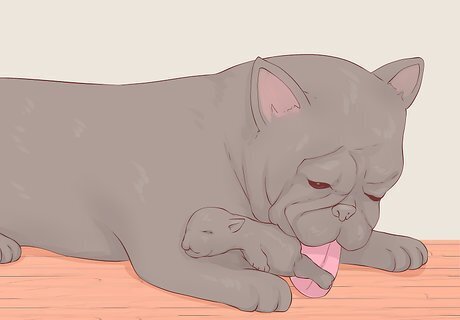
Make sure that the puppies are urinating and defecating. French Bulldog pups aren’t born knowing how to pee and poo. Their mom will generally stimulate these behaviors by licking their genitals and anus after each mealtime. If they do not, you will have to simulate her motherly duty. Use a cotton ball dipped in warm water to rub the appropriate places after the puppies have fed.

Wean the puppies. Start weaning the litter off of breast milk as soon as their teeth begin to appear, around four weeks. Take them from liquid to solid food slowly, eventually removing their mother during feeding times to ensure that they don’t go for her milk. Start by bowl feeding them with a high-quality puppy formula like Esbilac. Then, mix in some finely ground, high-quality puppy kibble to create a mushy gruel. Gradually add more finely ground dry puppy food with each meal, increasing its thickness until they’re ready for plain dry food. Introduce dry food alongside mush to encourage puppies to start eating it by choice. They should be able to eat kibble by the time they’re six weeks.

Start selling your puppies at eight weeks. Ideally, you’ll hand over each puppy when it’s between eight and 10 weeks old. This is old enough for your puppy to be healthy and well-socialized but still young enough to not have attachment problems that would make it more difficult to adjust to a new home.
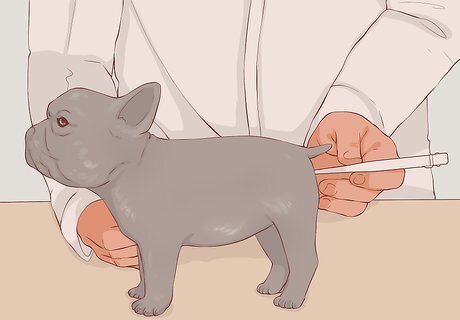
Take your puppies to the vet. The vet should have checked the puppies immediately after the c-section to ensure they were all healthy and free from obvious defects. After that, take the puppies in to start their vaccination cycle at six weeks. The whole litter should have a “5 in 1” vaccination (for canine distemper, hepatitis, coronavirus, parainfluenza, and parvovirus) every three weeks until they’re 16 weeks old. They should also have a rabies vaccine at 12+ weeks. The new owners will generally take care of many of these; just be sure that they know they need to register the puppy with a vet right away and continue the cycle of vaccines and parasite control.

Register your puppies with the American Kennel Club. As soon as they’re born, fill out a form that provides information about the parents, and the AKC will send you individual registration forms for each pup. AKC registration will show prospective buyers that you have certified purebred dogs for sale. You can do this via mail or online. Expect a two to six week turnaround time.
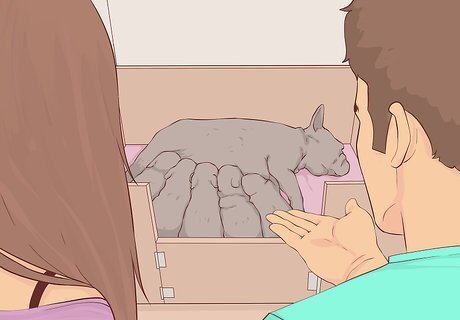
Be accountable to your buyers. Show your puppies with their mother in the facility where they were raised. Be able to produce pedigrees and health certifications for both parents that show they have been screened for common defects, and provide health guarantees for your puppies. French Bulldogs are susceptible to multiple genetic disorders. Responsible breeders will have their parent dogs screened for common defects, including brachycephalic airway syndrome, spinal malformations, hip and reproductive issues, and be able to produce independent certification from a vet that their stock tested negative. The parents’ health screening results should also be registered in the Canine Health Information Center database so that owners can look it up for verification. It’s also a good idea to become a registered breeder with the French Bulldog Club of America to gain referrals and show that you adhere to a strict code of ethics with regards to breeding.
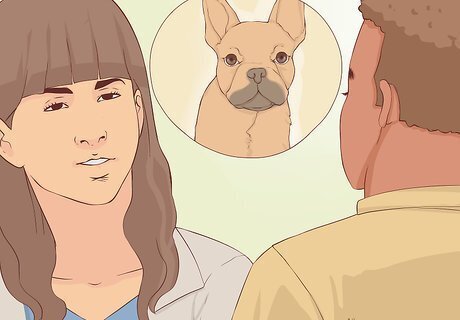
Vet potential owners before selling your puppies. Discuss the French Bulldog’s needs and temperament with prospective buyers, and inquire about their desires and lifestyle to ensure that they align. Visit their home to make sure that it’s a good environment for the puppy. Make sure that they're ready to be committed pet owners.
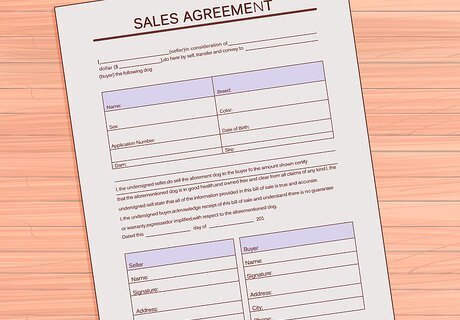
Create a written sales agreement. Signing a contract to seal the deal will establish you as a credible and transparent breeder while protecting the interests of you, the owner(s), and the puppy. Make sure that the document includes contact information for both parties, the names and American Kennel Club registration numbers for both parents, a description of the puppy, and a health guarantee clause that stipulates that a puppy can be returned for a full refund if any health issues are found upon an immediate veterinary screening. Many breeders also include a clause specifying that a puppy must be returned to them if the owners are no longer able to care for it.




















Comments
0 comment